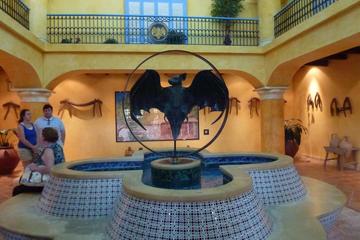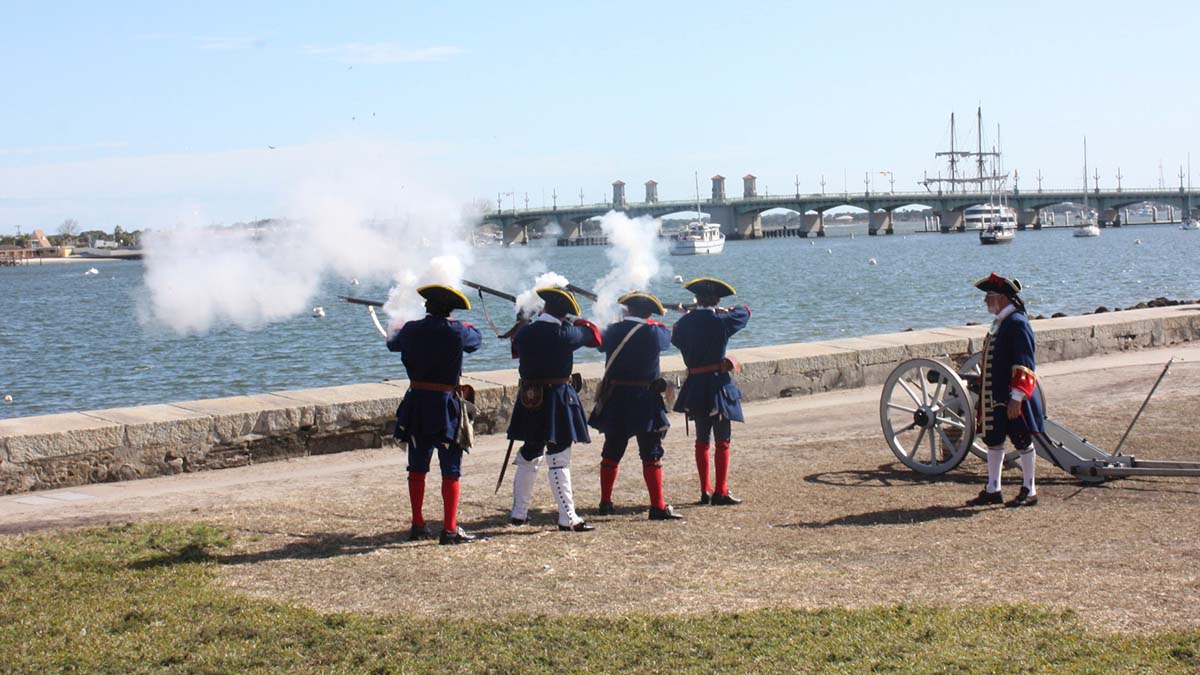
by Troy Herrick
In the 17th century, gold, silver and other treasures flowed into Spain like water from its overseas empire. Other European powers like Britain and Holland took careful notice of this wealth and commissioned privateers to “occasionally interrupt” the stream of treasure-laden galleons. The stakes were high and Spain had to protect its interests from the real “Pirates of the Caribbean” like Sir Francis Drake, Sir John Hawkins and Laurenz de Graaf. Dutch pirate Piet Heyn was particularly successful in capturing 90 tons of gold and silver, which was worth far more than a king’s ransom. Spain moved to turn the Caribbean Sea into its own mare nostrum (“our sea”) by constructing fortresses at a number of strategic sites including Puerto Rico, Florida and Mexico. Spanish ships could anchor in safe harbors as they gradually made their way to and from Europe.
Puerto Rico, the first major island with fresh water, was the gateway to the new world. The north equatorial ocean current and the northeast trade winds carried ships from distant Europe, 4000 miles away, right to its doorstep.
St. Augustine, Florida was the last port of call for galleons crossing the Atlantic back to Spain. The Gulf Stream carried the treasure-laden ships up the east coast of Florida right past this site before turning towards Europe.
Veracruz, Mexico was the site of the Spanish “Fort Knox.” Almost all the gold and silver from the new world passed through this city before being loaded onto galleons bound for Spain.
The Castillo San Felipe Del Morro and the Castillo San Cristobal – San Juan, Puerto Rico
In 1493 Christopher Columbus was the first European to land on Puerto Rico and the city of San Juan was established in 1521. The Spanish quickly realized that the nation controlling this settlement could shelter its vessels in the harbor behind strong fortifications and send its warships out to control the new world trade routes. Fortification of the island began in 1539 with the Castillo San Felipe del Morro (El Morro) and the structure you find now was essentially complete by 1790, except for a lighthouse that was added in 1846.
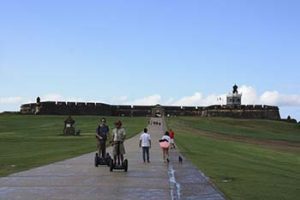 As we approached El Morro from town, we found ourselves crossing a large open field. This esplanade allowed defenders to shoot at anyone foolish enough to attack the fort by land. At the Sally Port, we purchased our admission tickets from the park ranger “sentry” and found ourselves standing on the parade square known as the Plaza de Armas.
As we approached El Morro from town, we found ourselves crossing a large open field. This esplanade allowed defenders to shoot at anyone foolish enough to attack the fort by land. At the Sally Port, we purchased our admission tickets from the park ranger “sentry” and found ourselves standing on the parade square known as the Plaza de Armas.
The periphery of the Plaza de Armas is lined with casemates which are vaulted rooms designed to disperse the weight of the structure above. Each casemate was originally designated for a specific use and now they house historical displays. The powder magazine houses a display of 10-12 inch diameter cannon balls and gunpowder casks. A bell over the entrance to one casemate marks the chapel; inside, hanging over the bare altar, you find a picture of the Virgin of the Navigators who watches over a harbor filled with old sailing vessels.
Descending the stairs to the lower level you find the casemates where soldiers lived and worked; these include barracks, kitchen and forge. After seeing these, visitors may be left with the impression that morale was very low in this Castillo. Life was rough and a soldier’s pay was not only small but also not guaranteed to be available either.
El Morro was designed to protect the harbor below from attack by sea. Unfortunately this fortress was not designed to protect the city. This weakness was exploited by the English in 1595 and 1598 and the Dutch in 1625 who all inflicted heavy damage to San Juan. Realizing their strategic error, the Spanish constructed the Castillo San Cristobal to protect San Juan, and El Morro, from a land-based attack.
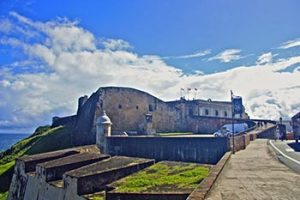 The Castillo San Cristobal began as a small triangular structure in 1634 and evolved into the largest fortification in the new world by 1782. The strength of this fortress was put to the test when the British attacked in April 1797. They were repulsed by the defenders and it was easy to see why when you consider that the main battery alone had over 30 heavy guns trained on the attackers. A neatly assembled pile of cannon balls still remains on the battery deck, just in case.
The Castillo San Cristobal began as a small triangular structure in 1634 and evolved into the largest fortification in the new world by 1782. The strength of this fortress was put to the test when the British attacked in April 1797. They were repulsed by the defenders and it was easy to see why when you consider that the main battery alone had over 30 heavy guns trained on the attackers. A neatly assembled pile of cannon balls still remains on the battery deck, just in case.
As with El Morro, San Cristobal has a number of casemates around the periphery of the Plaza de Armas. One was the barracks and it contained two long, low-lying beds, each accommodating 9 to 10 soldiers. Every soldier was issued a gray-brown woolen blanket. At the far end of each bed is a drum. You also find an example of an ammo pouch and a blue field pack with shoulder straps. What you do not see are uniforms because in the 17th century Spanish soldiers were not issued with these by the military. Instead they wore red sashes or badges as a means of distinguishing themselves from the enemy.
One unusual feature about the Castillo San Cristobal is that the chapel is not housed inside a casemate. Rather it is outside, exposed to the elements. It is not clear why this was the case.
Both fortresses feature a number of sentry boxes (garitas). Each accommodated a single guard and allowed for a 180-degree view of the area. There is an open entrance on the side and a slit from which the sentry could fire his rifle while at the same time minimizing his own exposure to return fire. The most infamous garita, known as the Devil’s Sentry Box, was situated below the northern wall of San Cristobal, just above the water. Soldiers were afraid to be posted here in the dark of night because it was believed to be haunted. You can visit this garita but only during daylight hours.
With the two fortresses, San Juan had become the most heavily fortified settlement in the Caribbean. While both castillos were besieged, neither ever fell to the enemy. The only time the Spanish were displaced was in 1898 when Puerto Rico became a U.S. Territory after the Spanish-American War.
Visitors should also note that the Castillo San Felipe del Morro and the Castillo San Cristobal are not the only fortresses in the vicinity. El Morro had a smaller twin, the Fortin de San Juan de la Cruz (also known as El Cañuelo), on the opposite shore of the bay; it is still clearly visible in the distance. Combined, they provided crossfire across the bay in case of enemy attack.
San Cristobal’s smaller twin is the Fortin San Jeronimo which still “protects” the San Antonio Bridge linking the islet of Old San Juan to the main island. Curiously while we were on the islet, a fleet of taxis blockaded the bridge to protest the recent licensing of Uber in the city. There was no response from the Fortin San Jeronimo at that time.
Castillo de San Marcos – St. Augustine, Florida
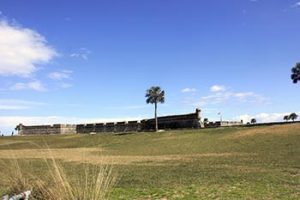 In 1565 Conquistador Pedro Menendez de Aviles, accompanied by 600 soldiers and colonists arrived in Florida to establish a series of “presidios” (fortified towns) to defend treasure-laden ships en route back to Spain. Construction of the Castillo de San Marcos, the most northerly of these presidios, was essentially complete by 1695. The bastion design allowed defenders to mount cannons in such a way as to get a clear shot at the enemy from every possible angle.
In 1565 Conquistador Pedro Menendez de Aviles, accompanied by 600 soldiers and colonists arrived in Florida to establish a series of “presidios” (fortified towns) to defend treasure-laden ships en route back to Spain. Construction of the Castillo de San Marcos, the most northerly of these presidios, was essentially complete by 1695. The bastion design allowed defenders to mount cannons in such a way as to get a clear shot at the enemy from every possible angle.
Walking across the field just outside the entrance of the Castillo, we encountered eight “Spanish” soldiers dressed in 18th century uniforms and shouldering muskets. [TOP PHOTO] The commanding officer barked out orders in Spanish to commence a rifle firing drill. Shortly after, the artillery men fired a three pound mortar. Curiously an incoming motor boat suddenly changed direction at the same time. It was well out of range by the time this piece of artillery was reloaded.
Entering the castillo, we crossed a well-worn wooden drawbridge to the Sally Port and passed a sentry holding a rifle with fixed bayonet. We found ourselves standing on the Plaza de Armas, which was again surrounded by casemates. Two casemates featured different types of cannon shot – solid cannon balls, bar shot, chain shot, grape shot and the long-handled tools (approximately 8 feet in length) required to load, fire and clean the big guns.
Barracks were equipped with two 26 foot long raised wooden platforms lining the walls of the casemate. Each had a single light gray mattress on top, capable of accommodating six soldiers. A short run outside brought the soldiers to la necessaria, an 18th century latrine featuring six seats and no privacy. The “modern” flushing system required a bucket of water drawn from a nearby barrel.
One casemate functioned as a treasury room where military pay chests, valuables and important documents were kept; another was a chapel with a stone altar set against the back wall.
The Castillo de San Marcos was never taken by force but in 1763 the St. Augustine colony was ceded to Britain after the Seven Years War. Spain would later reclaim St. Augustine in 1784 under the Treaty of Paris after having assisted the Americans during their Revolutionary War. Eventually in 1821, Florida was traded to the United States to settle a debt.
Fuerte de San Juan de Ulua – Veracruz, Mexico
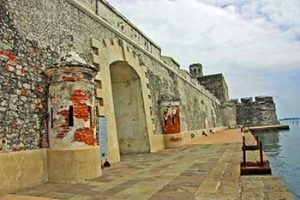 In 1518 Spanish conquistador Juan de Grijalva and 30 soldiers landed on a tiny island in the harbor of what is now Veracruz and named it San Juan de Ulua. The first fortifications were constructed in 1535 and then upgraded in 1600 after this site was appointed as an official repository for all treasures collected in the New World and the Philippines. After 172 years and several expansions, the bastion was completed. Its ramparts accommodated 250 cannons to provide a warm welcome for any undesirable visitors.
In 1518 Spanish conquistador Juan de Grijalva and 30 soldiers landed on a tiny island in the harbor of what is now Veracruz and named it San Juan de Ulua. The first fortifications were constructed in 1535 and then upgraded in 1600 after this site was appointed as an official repository for all treasures collected in the New World and the Philippines. After 172 years and several expansions, the bastion was completed. Its ramparts accommodated 250 cannons to provide a warm welcome for any undesirable visitors.
All incoming treasure was transported to Veracruz by mule train. This included much of the Andean gold and silver produced as well as exotic woods and spices from the Philippines, all of which converged at Acapulco on the Pacific Coast. Added to this was the Mexican gold and silver. Upon arrival at the Fuerte de San Juan de Ulua, this horde was catalogued and stored until the annual gold fleet gradually arrived from Spain. A secure storage facility was urgently required to handle the inconveniently large volumes of treasure that were assembled.
As we approached the site, we first passed a modern sentry box as this fort is situated on a Mexican naval base. After purchasing our admission tickets, we then stepped back in time and passed an old Spanish garita at the Sally Port.
Once inside at the Plaza de Armas, your first surprise is the beige façade with white leafy trim of the Casa del Gobernador (Governor’s House) that almost seems out-of-place with the rough-cut stone features of the other walls surrounding the plaza. A Spanish governor was installed here in 1601 to secure all of the treasure being shipped to Spain. The finely finished rooms of the Governor’s House now contain a museum displaying armour, pikes and flintlock pistols in addition to statues of saints, local indigenous pottery and figurines.
Typical of Spanish fortifications, the Plaza de Armas has casemates around the periphery. Unfortunately, those at San Juan de Ulua have been poorly maintained. Unique about these casemates is that they were used to store gold and silver. Look inside one of them and imagine a room filled with gold bars to a height of 4 feet or silver bars to a height of 6 feet. Each casemate was filled with enough precious metal to fill a single galleon to full capacity. The difference in height between gold and silver was necessitated because the former is much heavier and any greater volume of gold might potentially sink the ship. Once a casemate was filled to capacity, the precious metals were protected by large wooden doors and a padlock.
Climb the narrow staircase in the southeast corner of the Plaza de Armas to the second level. At the top of the stairs you find two observation towers that were constructed in 1584 to provide an early warning system in case of attack. The Baluarte de San Crispin in the southwest corner and the Baluarte de San Pedro in the southeast corner are both approximately 44 feet high. You also find a number of gun platforms strategically located around the ramparts on which to mount cannons.
Return to the Plaza de Armas and exit to the dock area on the south side of the fort. What you find is that there is only enough mooring space to accommodate 3 or 4 ships at a time. The wall along the docks is known as the Muro de las Argollas (wall of rings) and is named for the 35 heavy brass rings used to securely tie off the vessels while they were being loaded. Empty galleons were loaded to full capacity before they set sail to Havana and then eventually on to Puerto Rico and ultimately Cadiz or Seville in Spain.
The total volume of metals passing through the Fuerte de San Juan de Ulua each year would fill 60 to 80 galleons. At the same time it is impossible to believe that this huge stash of treasure was ever accumulated on site at any one time, as there was insufficient storage capacity. Logistically mule train delivery could not be coordinated with the arrival of the galleons. Since it was unlikely that the whole fleet arrived in Veracruz at the same time, there would likely have been sufficient time to replenish the treasure stores after they were depleted. It was only necessary to have enough treasure on hand to guarantee that each ship could be loaded to full capacity after they trickled into port.
Head back inside the fort and then exit by way of the Sally Port. Once outside, cross the drawbridge known as “The Bridge of Sighs” over to the Half-moon Bastion. This bastion housed political prisoners from 1755 to 1914. Up to 30 prisoners at a time were cruelly chained together in each dark, dank casemate. The only light source was two slits in the wall and water droplets continuously fell from the ceiling. Prisoners were arranged in such a way as to receive the Spanish version of the Chinese Water Torture. The prisoners have long since been replaced by short stalactites and stalagmites.
The Fuerte de San Juan de Ulua was designed to protect Spanish treasure and not the town of Veracruz just across the harbor. The Dutch exploited this weakness and sacked Veracruz in 1683 but the fort remained secure.
The fortress was never taken by force while it was under Spanish control. Even after Mexican independence from Spain in 1821, Spanish troops stubbornly occupied this site until November 1825 when they finally walked away into history.
If You Go:
The Castillo San Felipe del Morro and Castillo San Cristobal are both located in Old San Juan. A combination ticket to both is $5. The two sites are within walking distance of each other. They are also linked by the same trolley route. The trolley is free to ride.
You can visit the sites of El Cañuelo and the Fortin San Jeronimo but you cannot enter either of them. El Cañuelo has been filled with concrete by the U.S. National Park Service in order to prevent further deterioration and the Fortin San Jeronimo is closed behind a chain link fence.
The Castillo de San Marcos is located at 1 S. Castillo Drive St. Augustine, Florida. Admission is $10.
To reach the Fuerte de San Juan de Ulua in Veracruz, you must travel there by tour bus from the Malecon near the Mercado de Artesanias San Miguel Aleman Valdes on Avenida Insurgentes. The cost of the bus ride is 35 pesos. This does not include admission to the fort. The price of admission to the fort is 55 pesos. During the summer there is supposedly a boat that will take you directly across the harbor to the fort but our visit was in February so this cannot be confirmed.
About the author:
Troy Herrick, a freelance travel writer, has traveled extensively in North America, the Caribbean, Europe and parts of South America. His articles have appeared in Live Life Travel, International Living, Offbeat Travel and Travels Thru History Magazines.
Photographs:
All Photos by Diane Gagnon. A freelance photographer, she has traveled extensively in North America, the Caribbean, Europe and parts of South America. Her photographs have accompanied Troy Herrick’s articles in Live Life Travel, Offbeat Travel and Travels Thru History Magazines.




 by Susmita Sengupta
by Susmita Sengupta Mofongo. The name resonated with me, lyrical, pleasing, delightful and most importantly appetizing. I had arrived in San Juan, Puerto Rico for a spring break vacation accompanied by my husband and daughter. I had never heard of such a dish and I was eager to try it. The mofongo arrived accompanied by succulent shrimp bathed in a turmeric sauce laced with onions, tomatoes, bayleaf and spices. It was delicious. This was my introduction to the classic dish made of fried plantains that is pulverized in a mortar and pestle and mixed with garlicky olive oil and fried pork rinds and bacon. It is a dish that reflects the history and culture of this island.
Mofongo. The name resonated with me, lyrical, pleasing, delightful and most importantly appetizing. I had arrived in San Juan, Puerto Rico for a spring break vacation accompanied by my husband and daughter. I had never heard of such a dish and I was eager to try it. The mofongo arrived accompanied by succulent shrimp bathed in a turmeric sauce laced with onions, tomatoes, bayleaf and spices. It was delicious. This was my introduction to the classic dish made of fried plantains that is pulverized in a mortar and pestle and mixed with garlicky olive oil and fried pork rinds and bacon. It is a dish that reflects the history and culture of this island.
 Castillo San Felipe del Morro, commonly known as El Morro, is a 16th century, six level fortress. It was named in honor of Spain’s King Philip II. The fort went through several phases of construction beginning in 1539 when the Spanish felt a fort was needed to protect San Juan from attacks by pirates and privateers. In its first phase of construction between 1539-1540, it was a small structure at the entrance to San Juan harbor. Sir Francis Drake from England attacked the island in 1595 but the Spanish were able to defeat him. But in 1598, Sir George Clifford, the Earl of Cumberland, attacked El Morro and conquered the city. Although he could only hold the city for a very short period of time, it prompted the Spanish to improve the fortification of little El Morro. There was a flurry of construction beginning in the 1600s with the building of the walls that surrounded the city. The enlargement of El Morro started in 1765 and the entire process that began in 1539 took about 150 years to complete. Today, El Morro and its companion fort, Castillo San Cristobal which was built to protect El Morro from land attacks, are part of the US National Park Service and a UN designated World Heritage Site.
Castillo San Felipe del Morro, commonly known as El Morro, is a 16th century, six level fortress. It was named in honor of Spain’s King Philip II. The fort went through several phases of construction beginning in 1539 when the Spanish felt a fort was needed to protect San Juan from attacks by pirates and privateers. In its first phase of construction between 1539-1540, it was a small structure at the entrance to San Juan harbor. Sir Francis Drake from England attacked the island in 1595 but the Spanish were able to defeat him. But in 1598, Sir George Clifford, the Earl of Cumberland, attacked El Morro and conquered the city. Although he could only hold the city for a very short period of time, it prompted the Spanish to improve the fortification of little El Morro. There was a flurry of construction beginning in the 1600s with the building of the walls that surrounded the city. The enlargement of El Morro started in 1765 and the entire process that began in 1539 took about 150 years to complete. Today, El Morro and its companion fort, Castillo San Cristobal which was built to protect El Morro from land attacks, are part of the US National Park Service and a UN designated World Heritage Site.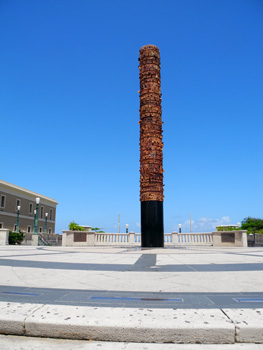 Our visit to El Morro started with our taxi dropping us off at the entrance to the fort from where we had to walk across a large, green field to enter the citadel. Be sure to wear sturdy walking shoes as there is a lot of walking involved. We took our time walking through the ramparts where we saw cannons still facing the ocean and stepped inside domed garitas or sentry boxes with its views of the Atlantic Ocean. We passed through passageways and storerooms and climbed the spiral and triangular staircases that go from level to level. On one level we saw an iguana sunning itself under the clear, blue sky with spectacular views of the ocean. By then, we were getting hungry and decided to take the free trolley from the fort entrance into the streets of Old San Juan. Although the best method is to walk the streets of the old city, the trolley is a wonderful way to get to those streets especially if one is hot and tired after spending the day at the fort.
Our visit to El Morro started with our taxi dropping us off at the entrance to the fort from where we had to walk across a large, green field to enter the citadel. Be sure to wear sturdy walking shoes as there is a lot of walking involved. We took our time walking through the ramparts where we saw cannons still facing the ocean and stepped inside domed garitas or sentry boxes with its views of the Atlantic Ocean. We passed through passageways and storerooms and climbed the spiral and triangular staircases that go from level to level. On one level we saw an iguana sunning itself under the clear, blue sky with spectacular views of the ocean. By then, we were getting hungry and decided to take the free trolley from the fort entrance into the streets of Old San Juan. Although the best method is to walk the streets of the old city, the trolley is a wonderful way to get to those streets especially if one is hot and tired after spending the day at the fort.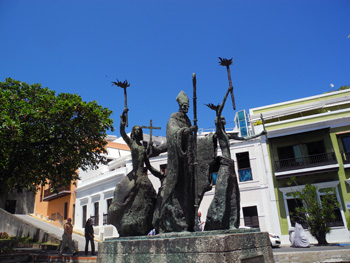 We got down near the Spanish Barracks, or the Cuartel de Ballaja that housed the Spanish troops in the 1800s and later housed American soldiers following the Spanish American war. The three story square building, with its series of arches and central courtyard is the last and the largest building built by the Spanish in the New World. Today it houses the Museum of the Americas. Just a step away from the Barracks, we came upon a massive totem sculpture. This was the Plaza del Quinto Centenario, inaugurated in 1992. Known as the Totem Telurico, it is a contemporary sculpture made by Puerto Rican artist Jaime Suarez and it represents 500 years of Puerto Rican post Columbian history.
We got down near the Spanish Barracks, or the Cuartel de Ballaja that housed the Spanish troops in the 1800s and later housed American soldiers following the Spanish American war. The three story square building, with its series of arches and central courtyard is the last and the largest building built by the Spanish in the New World. Today it houses the Museum of the Americas. Just a step away from the Barracks, we came upon a massive totem sculpture. This was the Plaza del Quinto Centenario, inaugurated in 1992. Known as the Totem Telurico, it is a contemporary sculpture made by Puerto Rican artist Jaime Suarez and it represents 500 years of Puerto Rican post Columbian history.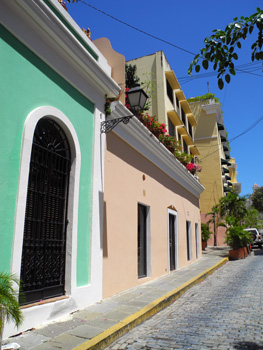 We walked through the narrow, cobblestoned streets of Old San Juan, a charming residential and commercial area, filled with shops, restaurants and wonderfully preserved homes in shades of blue, green and orange. And then we came upon El Convento, a hotel founded as a Carmelite convent more than 360 years ago. Sitting in the open air restaurant, under a breadfruit tree, we enjoyed a tapas lunch that included chicken croquettes, hummus and pita bread, calamari rings and their distinct, thin crust pizza. Near the El Convento is the Catedral de San Juan Bautista, a church of great historical importance. Although the history of the church begins in 1521, the structure we see today was built in 1540. Inside the church are the remains of Juan Ponce de Leon in a marble tomb. After spending a few moments in the serene, peaceful atmosphere we continued with our exploration of Old San Juan.
We walked through the narrow, cobblestoned streets of Old San Juan, a charming residential and commercial area, filled with shops, restaurants and wonderfully preserved homes in shades of blue, green and orange. And then we came upon El Convento, a hotel founded as a Carmelite convent more than 360 years ago. Sitting in the open air restaurant, under a breadfruit tree, we enjoyed a tapas lunch that included chicken croquettes, hummus and pita bread, calamari rings and their distinct, thin crust pizza. Near the El Convento is the Catedral de San Juan Bautista, a church of great historical importance. Although the history of the church begins in 1521, the structure we see today was built in 1540. Inside the church are the remains of Juan Ponce de Leon in a marble tomb. After spending a few moments in the serene, peaceful atmosphere we continued with our exploration of Old San Juan.
 The next day we decided to go the El Yunque National Rainforest, about a forty-five minute drive from San Juan. This is the only tropical rainforest in the US National Forest system. At the El Portal visitor center, located in the wet forest, we admired its spectacular architecture that merged in with the surrounding forest and watched a short movie describing the rainforest and its importance to the ecosystem. We stopped to take in the spectacular panoramic vistas of the forest from various viewing areas. We drove past native towns and into the winding roads on the Luquillo Mountains past bamboo groves, giant ferns, wildflowers, tropical hardwood trees, streams and waterfalls. We drove up to the Yokahu Observation Tower. The view from the top of the tower is truly spectacular and makes you forget the climb up.
The next day we decided to go the El Yunque National Rainforest, about a forty-five minute drive from San Juan. This is the only tropical rainforest in the US National Forest system. At the El Portal visitor center, located in the wet forest, we admired its spectacular architecture that merged in with the surrounding forest and watched a short movie describing the rainforest and its importance to the ecosystem. We stopped to take in the spectacular panoramic vistas of the forest from various viewing areas. We drove past native towns and into the winding roads on the Luquillo Mountains past bamboo groves, giant ferns, wildflowers, tropical hardwood trees, streams and waterfalls. We drove up to the Yokahu Observation Tower. The view from the top of the tower is truly spectacular and makes you forget the climb up.
